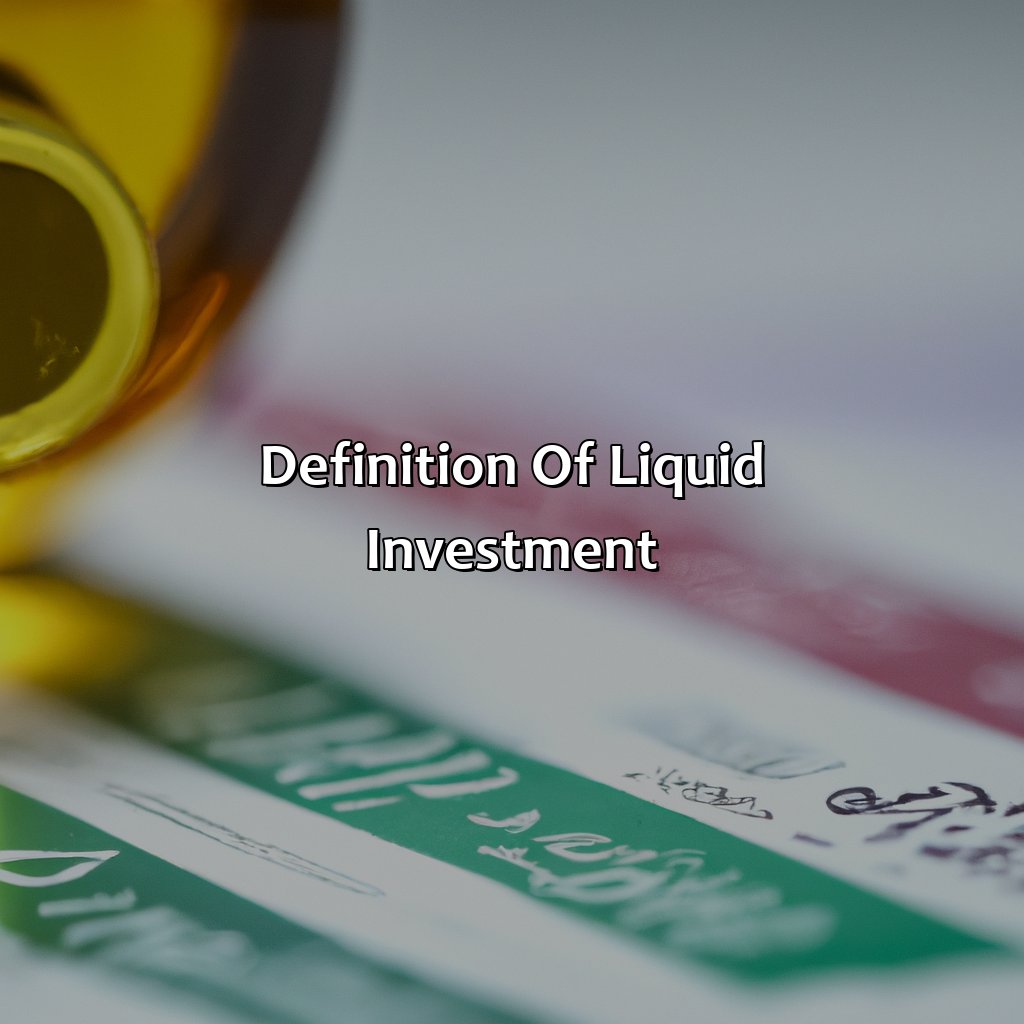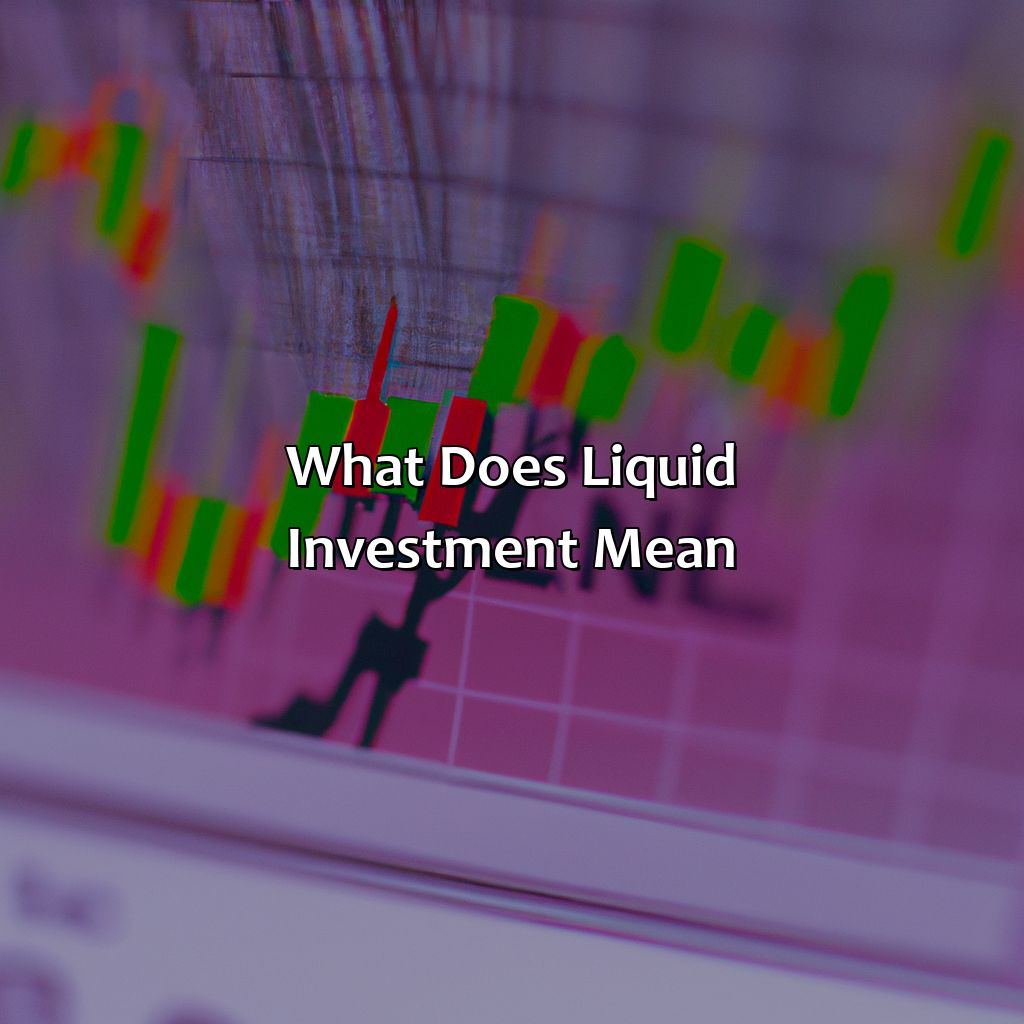What Does Liquid Investment Mean?
Key Takeaway:
- Liquid investments are assets that can easily be converted to cash without causing a significant change in the price of the asset.
- Cash, short-term marketable securities, exchange-traded funds (ETFs), mutual funds, commercial paper, and bonds are all examples of liquid investments.
- The advantages of liquid investments include easy access to cash, low risk, and flexibility. However, they may also have lower returns and be subject to inflation risk.
Are you confused about liquid investments and why they are important? Don’t worry, you’re not alone! This article will help you understand what liquid investments mean and why it’s important to have in your portfolio. With this knowledge, you can make sound financial decisions for your future.
Definition of Liquid Investment
Liquid Investments – A Professional Definition
Liquid investments refer to financial assets that can be easily bought or sold in the market without experiencing a significant price decline. Also known as marketable securities, these investments are highly liquid due to their ability to convert into cash within a short time frame.
These assets can be traded on organized exchanges or over the counter and include money market investments, stocks, bonds, and exchange-traded funds. Liquid investments are preferred by investors who prioritize liquidity and flexibility over higher returns.
It’s important to note that not all investments are liquid. Assets like real estate can take months or even years to sell, making them illiquid.
The history of liquid investments dates back to the creation of modern stock markets in the 17th century. The Amsterdam Stock Exchange is credited as being the first formal stock exchange where shares of the East India Company were traded. Since then, liquid investments have become an integral part of modern finance and are widely used by investors to achieve their financial goals.

Image credits: retiregenz.com by Harry Duncun
Types of Liquid Investments
To comprehend liquid investments with cash, short-term marketable securities, ETFs, and mutual funds, commercial paper, and bonds; investigate their potential advantages.
These benefits may include:
- the ease of access to your money,
- flexible investment options, and
- the scope of better returns.

Image credits: retiregenz.com by Harry Duncun
Cash and Cash Equivalents
The category of monetary assets that can be easily converted into cash is referred to as Cash and its Equivalent investment. Here are some examples in this category.
| Savings Account | The safest, most accessible form of liquid investment, with lower interest rates. |
| Certificate of Deposit (CD) | Similar to a Savings Account, only with a higher interest rate and minimum holding period. |
| Treasury Bills (T-Bills) | Institutional investment options containing higher-interest short-term government-backed debt securities that can be sold before maturity at their market price. |
Cash and Cash Equivalents type investment guarantees high liquidity and minimal financial risk. Additionally, all these investments share similar characteristics, such as having a low-interest rate and effectively zero investment risks.
To maximize the benefits of Cash and Cash Equivalent investments, consider creating an emergency fund in one or more of these options. One idea is to move money out of long-term savings accounts with bigger earnings prospects into any cash-equivalent marketplace whenever you deem it essential. Why settle for a long-term commitment when short-term marketable securities can give you the thrill of a fling with the stability of a relationship?
Short-term Marketable Securities
Liquid assets that can be easily converted into cash within a short period of time are known as Marketable Securities. These short-term securities include commercial paper, treasury bills, and money market funds. They are considered to be low-risk investments with high liquidity and low returns.
Marketable securities provide a viable option for investors who need quick access to cash without incurring major losses. Treasury bills are backed by the government, making them one of the safest investments available. Commercial paper, on the other hand, is issued by companies and is considered slightly riskier but offers higher returns.
In addition to the aforementioned securities, certificate of deposits (CDs) and municipal bonds also fall under this category. CDs offer guaranteed returns over a predetermined term while municipal bonds are issued by local governments to fund public projects.
Investors must carefully analyze their goals and financial situation before investing in marketable securities. It’s recommended to diversify the portfolio by investing in multiple securities to mitigate risks and maximize gains.
By understanding different types of liquid investments and their unique features, investors can make informed decisions that align with their financial goals.
ETFs and Mutual Funds, because sometimes you just need a group therapy session for your money.
Exchange-traded Funds (ETFs) and Mutual Funds
For the modern day investor, there are several alternatives of “fluid” investment options to choose from. One such option that comes to mind is Retrospectively Managed Funds and Market Trading Funds, but a comprehensive understanding of Exchange-traded Funds (ETFs) and Mutual Funds is crucial.
Below is a table with a quick comparison between Exchange-Traded Funds (ETFs) and Mutual Funds:
| Features | Exchange-Traded Funds(ETFs) | Mutual Funds |
|---|---|---|
| Structure | Traded on exchange like stocks | Not traded on an exchange |
| NAV calculation time | End of trading day(same as stocks) | At the end of each trading day(Full-day reflection of market situation) |
| Expense ratio | Lower-than-average expense ratios* | Slightly higher expense ratio than average |
While both ETFs and Mutual funds invest in stocks, bonds, or other securities, differences in structure have brought differences in their working principles. ETFs are mostly traded like stocks on the exchange which means their trade price changes throughout the day as per market predictions whereas mutual funds do not trade like stocks but instead settle end-of-day at their net asset value (NAV).
Interestingly enough, despite their similar investment goals, ETF’s low-cost structure offers an edge over mutual funds in terms of cost-effectiveness during bull markets.
According to Investopedia.com , “As of 2021, BlackRock’s iShares ETFS & Vanguard Group were among the largest providers of ETFs“.
Commercial paper and bonds – because sometimes investments are the only thing keeping us from crying ourselves to sleep at night.
Commercial Paper and Bonds
Liquid investments refer to assets that can be easily converted into cash. Commercial paper and bonds are two types of liquid investments that offer investors a low-risk income stream. Commercial paper is a short-term debt instrument issued by corporations or financial institutions to raise capital quickly for their operational needs. Bonds, on the other hand, are debt securities issued by companies, governments or municipalities to finance long-term projects or programs.
Both commercial paper and bonds provide investors with regular interest payments and the return of principal upon maturity. They are considered less risky than stocks because they have a fixed rate of return and are typically backed by the issuer’s creditworthiness. Furthermore, these investments can also be bought and sold on secondary markets, making them highly liquid.
It’s important to note that commercial paper tends to have a higher yield than bonds due to its shorter maturity period, but it also poses a higher credit risk since it may not be secured with collateral.
Investors who prioritize liquidity should consider including commercial paper and bonds as part of their investment portfolio. These assets provide investors with the flexibility to adjust their investments based on changes in the market while preserving principal and earning consistent returns.
In 2008 during the global financial crisis, Lehman Brothers filed for bankruptcy, causing multiple corporate bond issuers’ failures across the US; ironically triggering more demand for commercial papers given its relatively safer backing by high-quality firms such as IBM and Apple Inc., sending yields lower and coping with overall market uncertainty.
Being able to quickly turn your investments into cash is great, unless you’re tempted to blow it all on a spur-of-the-moment trip to Vegas.
Advantages and Disadvantages of Liquid Investments
To get the full picture of liquid investments, like stocks and bonds, we split this section into two parts. The first part will go over the big benefits of liquid investment. And the second part will show the possible drawbacks.

Image credits: retiregenz.com by James Jones
Advantages
To Flourish- Benefits of Liquid Investments
Liquid investments can provide several benefits to an investor. These investments are the ones that can be sold or liquidated without significant loss of value. Here are some advantages of liquid investments:
- Easy access to cash: In case of an emergency, investors can easily access their cash by selling their liquid investments.
- Reduced risk: With liquid investments, investors do not have to worry about losing their investment due to market fluctuations or other unforeseen events as they can sell it quickly for cash.
- Flexibility: Investing in liquid assets provides flexibility as investors can quickly shift from one investment to another depending on market conditions.
- Transparency: Liquid assets have a high degree of transparency compared to illiquid assets because they are traded in public markets where prices and other information are readily accessible.
- Diversification: Investing in a range of liquid assets enables an investor to diversify their portfolio, reducing risks and increasing profit potential.
Moreover, it is essential to note that while liquidity provides several benefits for an investor, it may not always be the ideal investment choice. It needs prudent consideration of factors such as investment goals, time horizon, tax implications before investing.
According to Forbes magazine’s report “Investing 101,” Liquid Investments like Treasury Bills adhere well when interest rates rise since their payments adjust with the changes.
Therefore, as discussed here, several drawbacks come with negative sides but mustn’t be treated with levity while putting them into consideration when choosing sound financial decisions.
Disadvantages
Liquid Investments: Disadvantages
Liquid investments come with a host of advantages, but they also have some drawbacks. Here are six disadvantages of liquid investments:
- Lower Returns – Compared to illiquid investments that require a longer holding period, liquid investments provide lower returns.
- Mental impulses – Investors may act on mental impulses and trade impulsively during market oscillations leading to losses.
- Market volatility – During highly volatile market conditions, liquid investments can be prone to significant losses as well as higher transactions expenses.
- Breeds habit of greed – Liquid investment can breed a habit of quick gratification and may lead to the lack of disciplined investment behavior over time.
- Limited diversification – Liquid investments mainly focus on stocks and mutual funds that do not provide enough diversification opportunities to an investor’s portfolio.
- Short term gain vs long term benefits – These types of investment mostly attract day traders who aim for short-term profits rather than long-term gains.
In summary, Liquid investments come with its fair share of disadvantages that investors must consider before investing.
Investors must weigh the risks involved and their financial goals before engaging in such investment avenues.
Fearful of missing out? Don’t let it influence your decision-making process. It is always better to stay cautious when investing your hard-earned money in any asset class. Remember that patience is key to creating wealth over the long term.
Five Facts About Liquid Investments:
- ✅ Liquid investments refer to assets that can be easily and quickly converted into cash without significant loss of value. (Source: Investopedia)
- ✅ Examples of liquid investments include stocks, bonds, and money market funds. (Source: The Balance)
- ✅ Liquid investments provide investors with flexibility and can be useful in times of financial need. (Source: NerdWallet)
- ✅ Liquid investments are generally considered less risky than illiquid investments, which may be difficult to sell quickly or without incurring a loss. (Source: Forbes)
- ✅ The liquidity of an investment can affect its return potential and should be taken into consideration when making investment decisions. (Source: The Motley Fool)
FAQs about What Does Liquid Investment Mean?
What does liquid investment mean?
Liquid investment refers to an investment that can be easily converted into cash without any significant loss of value, meaning it can be bought and sold quickly and with minimal transaction costs.
What are some examples of liquid investments?
Examples of liquid investments include stocks, exchange-traded funds (ETFs), mutual funds, high-quality corporate bonds, and money market instruments such as Treasury bills and certificates of deposit.
How is liquidity measured in an investment?
Liquidity can be measured by the bid-ask spread, which is the difference between the highest price a buyer is willing to pay for an asset – the bid – and the lowest price a seller is willing to accept for it – the ask. The tighter the bid-ask spread, the more liquid an asset is.
Why are liquid investments important?
Liquid investments are crucial because they provide quick access to cash in case of emergencies or unexpected expenses. They also offer flexibility and allow investors to take advantage of new opportunities or to adjust their portfolios quickly in response to changing market conditions.
What are the risks associated with liquid investments?
The main risk associated with liquid investments is the potential for market volatility, which can cause the value of the investment to fluctuate rapidly. Additionally, investors may suffer losses if they are forced to sell their investment during a downturn in the market or if they invest in a speculative asset with a high degree of risk.
How can I determine if an investment is liquid?
You can determine whether an investment is liquid by researching its trading volume, bid-ask spread, and the ease with which the asset can be sold. A liquid investment will have a robust trading volume and a tight bid-ask spread, while an illiquid investment may have low trading activity and large spreads.


